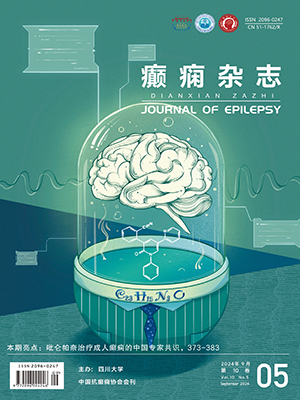| 1. |
Chen Z, Brodie MJ, Liew D, et al. Treatment outcomes in patients with newly diagnosed epilepsy treated with established and new antiepileptic drugs: a 30-year longitudinal cohort study. JAMA Neurol, 2018, 75(3): 279-286.
|
| 2. |
Laxer KD, Trinka E, Hirsch LJ, et al. The consequences of refractory epilepsy and its treatment. Epilepsy Behav, 2014, 37: 59-70.
|
| 3. |
Asnis-Alibozek A, Detyniecki K. The unmet need for rapid epileptic seizure termination (REST). Epilepsy Behav Rep, 2020, 25(15): 100409.
|
| 4. |
Trinka E, Cock H, Hesdorffer D, et al. A definition and classification of status epilepticus--Report of the ILAE Task Forc. Evidence-based guideline: treatment of convulsive status epilepticus in children and adults: report of the Guideline Committee of the American Epilepe on Classification of Status Epilepticus. Epilepsia, 2015, 56(10): 1515-1523.
|
| 5. |
Glauser T, Shinnar S, Gloss D, et al, Dodson insy Society. Epilepsy Curr, 2016, 16(1): 48-61.
|
| 6. |
National Institute for Health and Care Excellence: Guidelines. Epilepsies children, young people and adults. London: National Institute for Health and Care Excellence (NICE), 2022, 27.
|
| 7. |
Chung S, Szaflarski JP, Choi EJ, et al. A systematic review of seizure clusters: Prevalence, risk factors, burden of disease and treatment patterns. Epilepsy Res, 2021, 177: 106748.
|
| 8. |
Detyniecki K, O'Bryan J, Choezom T, et al. Prevalence and predictors of seizure clusters: A prospective observational study of adult patients with epilepsy. Epilepsy Behav, 2018, 88: 349-356.
|
| 9. |
Jafarpour S, Hirsch LJ, Gaínza-Lein M, et al. Seizure cluster: definition, prevalence, consequences, and management. Seizure, 2019, 68: 9-15.
|
| 10. |
Herman ST, Detyniecki K, O'Hara K, et al. Written seizure action plans for adult patients with epilepsy: Distilling insights from emergency action plans for other chronic conditions. Epilepsy Behav, 2023, 140: 109002.
|
| 11. |
Kienitz R, Kay L, Beuchat I, et al. Benzodiazepines in the management of seizures and status epilepticus: a review of routes of delivery, pharmacokinetics, efficacy, and tolerability. CNS Drugs, 2022, 36(9): 951-975.
|
| 12. |
Blond BN, Hirsch LJ. Updated review of rescue treatments for seizure clusters and prolonged seizures. Expert Rev Neurother, 2022, 22(7): 567-577.
|
| 13. |
Samanta D. Rescue therapies for seizure emergencies: current and future landscape. Neurol Sci, 2021, 42(10): 4017-4027.
|
| 14. |
Dingledine R, Varvel NH, Dudek FE. When and how do seizures kill neurons, and is cell death relevant to epileptogenesis? Adv Exp Med Biol, 2014, 813: 109-22.
|
| 15. |
Barcia Aguilar C, Amengual-Gual M, Sánchez Fernández I, et al. Time to treatment in pediatric convulsive refractory status epilepticus: the weekend effect. Pediatr Neurol, 2021, 120: 71-79.
|
| 16. |
Dobesberger J, Ristić AJ, Walser G, et al. Duration of focal complex, secondarily generalized tonic-clonic, and primarily generalized tonic-clonic seizures--a video-EEG analysis. Epilepsy Behav, 2015, 49: 111-117.
|
| 17. |
Theodore WH, Porter RJ, Albert P, et al. The secondarily generalized tonic-clonic seizure: a videotape analysis. Neurology, 1994, 44(8): 1403-1407.
|
| 18. |
Meritam Larsen P, Wüstenhagen S, Terney D, et al. Duration of epileptic seizure types: a data-driven approach. Epilepsia, 2023, 64(2): 469-478.
|
| 19. |
Jenssen S, Gracely EJ, Sperling MR. How long do most seizures last: a systematic comparison of seizures recorded in the epilepsy monitoring unit. Epilepsia, 2006, 47(9): 1499-1503.
|
| 20. |
中国抗癫痫协会共患病专业委员会. 癫痫伴抑郁诊断治疗的中国专家共识(2022修订版). 癫痫杂志, 2022, 8(6): 488-493.
|
| 21. |
ILAE. Post-ictal psychosis: identification, treatment and prevention. Epigraph, 2020, 22(2): 5S288-300.
|




